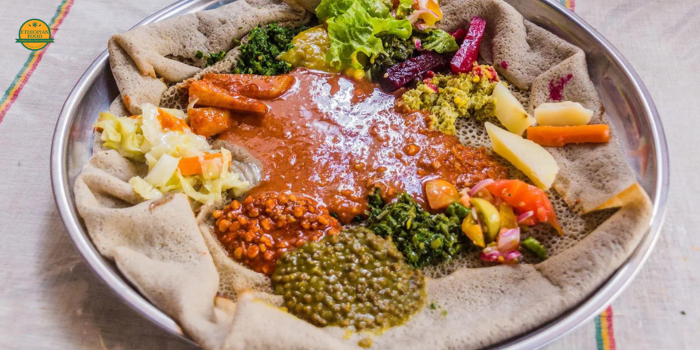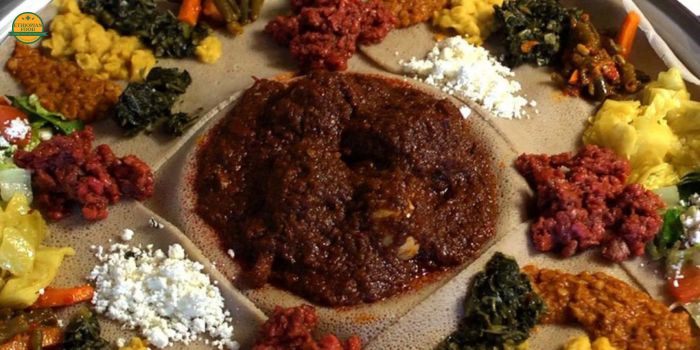Injera is a spongy, tangy flatbread that forms an integral part of the Ethiopia Food. It is made from teff flour, a tiny, nutrient-rich ancient grain native to the Horn of Africa. Injera Ethiopian Food serves as a utensil, plate, and accompaniment to various stews and dishes in these regions. Preparing injera Recipe is a multi-day process that involves fermentation, resulting in its distinctive flavor and texture.
Where is the Origin of Injera?
The Origin of Injera is in Ethiopia and Eritrea, which are located in the Horn of Africa region. Ethiopia is considered the primary place of origin for injera. Making and consuming injera has been ingrained in Ethiopian food culture for many centuries. Eritrea, which was once part of Ethiopia until gaining independence in 1993, also has a long tradition of making and eating injera that dates back hundreds of years.
The practice of fermenting teff flour batter to make the spongy, slightly sour injera bread developed indigenously among ethnic groups inhabiting the northern Ethiopian Highlands and Eritrean Highlands.
Teff, the tiny ancient grain used to make injera, is believed to have been cultivated first in the Ethiopian Highlands as early as 4000 BC.
So while injera is consumed in Eritrea and among Eritreans today, most scholars point to the origins lying in the traditions of the ethnic groups historically based in what is modern-day Ethiopia. The combination of using teff flour and the fermentation process has extremely deep roots in this region of the Horn of Africa.
What is Teff Injera?
Teff Injera is a gluten-free grain that has been cultivated in Ethiopia for thousands of years. It is the smallest grain in the world, with each kernel being about the size of a poppy seed. Despite its tiny size, teff is packed with nutrients, including protein, fiber, iron, calcium, and other essential minerals.
Ingredients
- 2 cups teff flour
- 1 teaspoon active dry yeast or 1/2 cup starter from a previous batch of injera
- 1/2 teaspoon salt
- 4 cups warm water
- Equipment
- Large non-reactive bowl
- Whisk or wooden spoon
- Measuring cups and spoons
- Injera pan or large non-stick skillet
- Pastry brush or paper towel
- The Fermentation Process
Step 1: Mixing the Batter
In a large non-reactive bowl, whisk together the teff flour, yeast (or starter), and salt. Gradually add the warm water while whisking continuously to prevent lumps from forming. The batter should have the consistency of crepe batter, slightly thicker than milk.
Step 2: Fermentation
Cover the bowl with a clean kitchen towel and let the batter ferment at room temperature for 24 to 72 hours. The longer the fermentation time, the more sour and bubbly the batter will become. Stir the batter periodically to allow air to circulate.
Step 3: Monitoring the Fermentation
During the fermentation process, you should notice bubbles forming on the surface of the batter, and the aroma should become slightly sour and yeasty. This is an indication that the fermentation is progressing well.
How to Make Injera Step by Step?

Here is the Process through which you will get to know how to make Injera step by step.
Step 1: Preparing the Pan
Heat an injera pan or a large non-stick skillet over medium heat. If using a non-stick skillet, it’s recommended to use a well-seasoned cast iron or carbon steel pan for best results.
Step 2: Greasing the Pan
Using a pastry brush or a paper towel, lightly grease the pan with a small amount of vegetable oil or niter kibbeh (spiced clarified butter).
Step 3: Pouring the Batter
Gently stir the fermented batter to incorporate any sediment that has settled at the bottom. Using a ladle or a measuring cup, pour a small amount of batter onto the center of the hot pan, just enough to cover the bottom in a thin, even layer.
Step 4: Cooking
Cook the injera for about 1 to 2 minutes, or until the edges start to curl and the surface appears dry and bubbly. The bottom should be lightly speckled with brown spots.
Step 5: Removing the Injera
Using a spatula or your fingers, gently lift the edges of the injera and peel it off the pan. Transfer the cooked Injera Ethiopian Food to a plate or a clean kitchen towel.
Step 6: Stacking and Covering
Stack the cooked injera one on top of the other, making sure to cover them with a clean kitchen towel or a lid to keep them warm and prevent them from drying out.
These are the processes from which you will get to Know how to make Injera step by step.
Serving and Storing Injera Recipe
Injera Recipe is traditionally served as an edible utensil and a base for scooping up stews, curries, and various vegetable and meat dishes. It’s common to tear off pieces of injera and use them to scoop up the flavorful sauces and stews.
If you have any leftover injera, it can be stored in the refrigerator for up to 5 days. Place the injera in an airtight container or wrap it tightly in plastic wrap or aluminum foil to prevent it from drying out. Injera Ethiopian Food can also be frozen for up to 3 months.
How to Reheat Injera?
Here are some tips for How to Reheating Injera (the spongy flatbread used in Ethiopian cuisine):
- Wrap the leftover injera in a damp towel or paper towels. The moisture will help keep the injera soft and pliable as it reheats.
- Place the wrapped injera on a microwave-safe plate and microwave for 20-30 seconds. The damp towel will create steam to re-soften the injera.
- You can also reheat injera in a dry skillet or flat pan over medium-low heat for 30 seconds to 1 minute per side. Cover the pan to trap steam.
- For oven reheating, wrap injera in foil and place in a 300°F oven for 5-10 minutes until heated through.
- If the injera is very stale or dried out, mist or brush it lightly with water before reheating to help it re-soften.
- Flip or rotate the injera occasionally as it reheats to prevent any hard spots from developing.
The key is using gentle, low heat and moisture to re-soften the injera without making it soggy or drying it out further. Properly reheated, injera should become soft, pliable and have its signature spongy texture again.
Variations and Accompaniments of Injera

While traditional injera recipe is made solely from teff flour, you can experiment with different flour combinations. Some variations include mixing teff with whole wheat flour or adding a small amount of rice or corn flour to the batter.
Injera Ethiopian Food is often served with various stews and dishes, such as:
Doro Wat: A spicy chicken stew made with berbere spice blend, onions, and hard-boiled eggs.
Misr Wat: A rich, spicy lentil stew flavored with berbere and niter kibbeh.
Gomen Besiga: Sautéed collard greens or kale with garlic, ginger, and spices.
Shiro Wat: A creamy chickpea stew seasoned with berbere and niter kibbeh.
Ayib: Fresh, soft cheese made from cow’s or goat’s milk, often served as a side dish or mixed into stews.
Injera recipe is a labor of love, but the tangy, spongy texture and the satisfaction of enjoying this traditional flatbread with flavorful Ethiopian dishes make it well worth the effort.
The traditional way to enjoy Injera Ethiopian Food is to tear off pieces of the spongy flatbread and use them to scoop up the flavorful sauces and stews. The tangy and slightly sour flavor of injera complements the rich and spicy flavors of Ethiopian dishes, creating a harmonious and satisfying culinary experience.
Cultural Significance of Injera
In Ethiopian culture, Injera recipe holds a special place. It is a symbol of hospitality and community, as it is often shared among family and friends during traditional coffee ceremonies or festive gatherings.
The process of making Injera Ethiopian Food is also deeply rooted in tradition, with recipes and techniques passed down from generation to generation. It is not uncommon for families to have their own secret starter cultures, which are carefully nurtured and shared among relatives, ensuring the preservation of their unique injera flavor.
FAQs Regarding Ethiopian Food Injera
How is injera traditionally made?
Injera, the spongy Ethiopian flatbread, is traditionally made by fermenting a batter of teff flour and water over several days. The fermented batter is then poured onto a hot circular griddle and cooked into large, thin pancake-like rounds.
Is injera gluten free?
Yes, injera is gluten-free. It is made from teff flour, which comes from an ancient grain that does not contain gluten.
Is injera a carb or protein?
Injera is primarily a carbohydrate source. It is made from teff flour, which is high in carbs and relatively low in protein.
Can Celiacs eat injera?
No, celiacs cannot eat traditional injera. Teff flour, the main ingredient in injera, contains gluten which is harmful for those with celiac disease.
Is Injera healthy?
Injera can be considered a healthy food option. It is high in fiber, iron, and calcium, and provides beneficial probiotics from the fermentation process.
Is injera really sour?
Yes, injera has a distinctly sour taste. The fermentation process that injera batter undergoes results in its signature sour flavor.
Is injera good for stomach?
Injera is believed to be good for digestion. The fermentation process produces probiotics and nutrients that may benefit gut health.
Where is the Origin of injera?
The Origin Of Injera is in Ethiopia and Eritrea, which are located in the Horn of Africa region.
Conclusion
Injera is more than just a flatbread. It is a culinary masterpiece that embodies the rich cultural heritage of Ethiopia. Its tangy flavor, spongy texture, and nutritional value make it a beloved staple in households across the country and beyond. Whether enjoyed as part of a traditional Ethiopian feast or as a gluten-free alternative to bread, injera Recipe is a true celebration of flavor, tradition, and culinary ingenuity.

